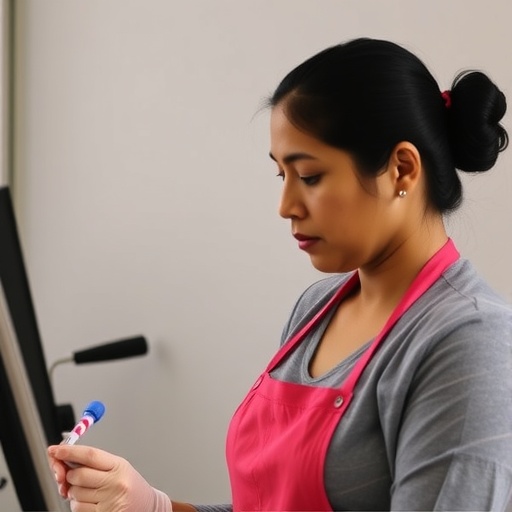In a groundbreaking study published in the Journal of Exposure Science & Environmental Epidemiology, researchers from Silent Spring Institute alongside collaborators from the University of California, Berkeley, and the University of California, San Francisco, have illuminated a critical yet overlooked dimension of occupational health risks affecting immigrant women in the United States. This pioneering research delves into the intersection between occupational chemical exposures and heightened breast cancer risk among immigrant women, a demographic historically marginalized in environmental health studies.
The investigation capitalizes on extensive data sets, including analyses of U.S. Census figures and the Women’s Occupations and Risk from Chemicals Project, to identify prevalent occupations among foreign-born women in the U.S. and to link those jobs to chemical exposures known or suspected to be implicated in breast carcinogenesis. The study meticulously combines epidemiological data with toxicological insights to craft a nuanced understanding of how workplace chemical environments contribute to cancer risk disparities.
Occupational health research has long been skewed towards male-dominated industries, leaving significant gaps in understanding the specific vulnerabilities experienced by women, and particularly immigrant women, in the workforce. The study’s lead author, Dr. Kristin Knox, emphasized the imperatives of this approach, highlighting how certain occupational roles commonly held by immigrant women could elucidate observed patterns of increased breast cancer incidence following migration to the U.S.
House cleaning, nursing, cashier work, janitorial duties, and caregiving emerge as the dominant occupational categories in this demographic. Among these, house cleaners and nurses were identified as facing the most extensive potential exposures to a variety of chemical agents with endocrine-disrupting properties. These substances include complex mixtures of synthetic fragrances, industrial cleaning agents, pesticides, phthalates, antimicrobial compounds, and alkylphenols. The biochemical mechanisms by which these chemicals perturb hormonal homeostasis are directly relevant to breast tissue pathophysiology and neoplastic transformation.
The study’s insights extend beyond mere hazard identification, uncovering substantial disparities driven by socio-economic factors such as educational attainment and language proficiency. Immigrant women with higher educational levels and greater English fluency were disproportionately represented in occupations characterized by lower chemical exposures—such as accounting, customer service, and software development—whereas those with limited language skills and fewer educational credentials frequently occupied higher-risk roles.
These disparities are compounded by systemic barriers that immigrant women face, including linguistic obstacles, undocumented status fears, and economic insecurity, which collectively reduce their capacity to advocate for safer working conditions or seek protection from toxic workplace environments. Co-author Erin Carrera, a registered nurse and study contributor, stressed the urgency of these findings, calling for enhanced protective policies and support systems tailored to this vulnerable workforce segment.
A novel phase of the research initiative is underway, distinguished by direct exposure assessment methodologies. Participating women from identified high-risk groups will wear silicone wristbands capable of passively sampling airborne chemical contaminants. Complementary urine analyses will quantify internal dose metrics of relevant xenobiotics, while qualitative interviews will capture the psychosocial dimensions of workplace hazard experiences. This integrated approach represents a significant methodological advancement in occupational exposure science.
The anticipated outcomes of this comprehensive exposure characterization are far-reaching, providing empirical evidence to inform policy reforms and workplace interventions. For instance, healthcare facilities could adopt safer disinfectant protocols and material handling procedures that curtail exposure to harsh chemicals among nursing staff. Likewise, domestic workers and their employers could benefit from clear guidance on selecting and utilizing less toxic products, potentially transforming hazardous occupational environments into safer venues for immigrant women.
This research is timely given the persistent underrepresentation of women, particularly immigrant women, in occupational health surveillance and cancer epidemiology. By bridging critical knowledge gaps through rigorous data analysis and community-engaged exposure monitoring, the study advances both scientific understanding and public health practice. It underscores the importance of intersectional approaches to occupational risk assessment incorporating gender, migration status, language, and education in health equity paradigms.
The funding for this significant work comes from the California Breast Cancer Research Program and generous charitable contributions to Silent Spring Institute, underscoring the importance of sustained financial support for translational environmental health research targeting vulnerable populations. This study not only sets a precedent for future investigations but also calls for immediate action to protect workers against insidious chemical exposures silently shaping their cancer risk.
As occupational exposures remain an underestimated determinant of breast cancer disparities, strategies informed by this research promise to enhance workplace safety regulations and workforce education programs. Ensuring equitable protection for immigrant women is not only a question of occupational justice but also a critical component of comprehensive cancer prevention strategies nationwide.
Through this investigative lens, the Silent Spring-led research illuminates a pressing public health issue that transcends traditional occupational health boundaries, bridging epidemiology, toxicology, sociology, and environmental justice. The study’s multifaceted approach offers a compelling model for future inquiries seeking to unravel complex exposure-disease relationships in diverse and underserved worker populations.
Subject of Research: People
Article Title: Breast cancer-related occupational exposures facing immigrant women
News Publication Date: 20-Oct-2025
Web References: https://doi.org/10.1038/s41370-025-00808-9
References: Knox, K.E., J.L. Ohayon, E. Carrera, R. A. Rudel and R. Morello-Frosch. 2025. Breast cancer-related occupational exposures facing immigrant women. Journal of Exposure Science & Environmental Epidemiology. DOI: 10.1038/s41370-025-00808-9
Keywords: Occupational diseases, Breast cancer, Public health, Environmental health




